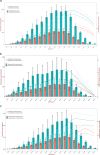Global, regional and national burden of rheumatoid arthritis from 1990 to 2021, with projections of incidence to 2050: a systematic and comprehensive analysis of the Global Burden of Disease study 2021
- PMID: 40128880
- PMCID: PMC11931880
- DOI: 10.1186/s40364-025-00760-8
Global, regional and national burden of rheumatoid arthritis from 1990 to 2021, with projections of incidence to 2050: a systematic and comprehensive analysis of the Global Burden of Disease study 2021
Abstract
Background: To provide insights into rheumatoid arthritis (RA) epidemiological trends, including prevalence, incidence, disability-adjusted life years (DALYs), corresponding average annual percentage change (AAPC), gender disparities, regional variations, age-specific rates, socio-economic correlations, risk factors, and future projections.
Methods: Data were extracted from the Global Burden of Disease Study (GBD) 2021. AAPC was calculated by joinpoint regression and two-sample Mendelian randomization (MR) analysis was performed to verify the causal relationship between the smoking factor and RA. The future incidence trend was predicted by the Bayesian age-period-cohort (BAPC) model.
Results: Global age-standardized prevalence rate (ASPR) and age-standardized incidence rate (ASIR) increased significantly while age-standardized DALYs rate (ASDR) decreased from 1990 to 2021. Regional variations were pronounced, with Andean Latin America reporting the highest burden. Females consistently exhibited higher age-standardized rate (ASR) across all metrics. Age-specific prevalence, incidence, and DALYs rates peaked at different age groups, highlighting complex demographic dynamics. Socio-demographic index (SDI) analysis demonstrated a positive correlation between RA burden and socio-economic development. The two-sample MR analysis confirmed a causal effect between smoking and RA. From 2022 to 2050, the ASIR will increase moderately.
Conclusions: The study underscores the escalating burden of RA globally, emphasizing the need for healthcare providers to be aware of the effects of aging populations and other societal factors on the risk of developing RA, and to develop targeted interventions, including smoking cessation programs, age- and gender-appropriate healthcare, and early diagnosis strategies.
Keywords: Autoimmune disease; Global burden of disease; Public health; Rheumatoid arthritis.
© 2025. The Author(s).
Conflict of interest statement
Declarations. Ethics approval and consent to participate: Not applicable. Consent for publication: Not applicable. Competing interests: The authors declare no competing interests.
Figures






References
-
- Almutairi K, Nossent J, Preen D, Keen H, Inderjeeth C. The global prevalence of rheumatoid arthritis: a meta-analysis based on a systematic review. Rheumatol Int. 2021;41(5):863–77. 10.1007/s00296-020-04731-0. - PubMed
-
- Cao F, He YS, Wang Y, Zha CK, Lu JM, Tao LM, et al. Global burden and cross-country inequalities in autoimmune diseases from 1990 to 2019. Autoimmun Rev. 2023;22(6): 103326. 10.1016/j.autrev.2023.103326. - PubMed
LinkOut - more resources
Full Text Sources

